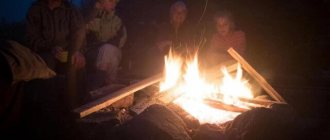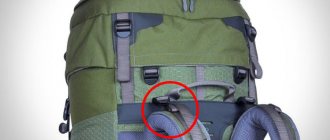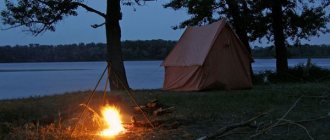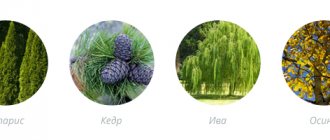How does camp food differ from regular city food?
Camping food is a sort of Spartan version of city food. The main criterion here is weight. And if you consider that on average, on a hike, one person takes 600 grams of food for each day, then in the first days of a 10-day hike, in addition to equipment, he will have to carry about 6 kg of food.
Therefore, when compiling a list, preference is given to the lightest and most compact products: cereals, nuts, energy bars, as well as dried/freeze-dried vegetables and fruits. Dried vegetables and fruits are easy to prepare at home, in a conventional oven or in an electric dryer. After drying, their weight decreases by 10-50! times and is well restored during cooking. If you don’t want to cook yourself, you can purchase ready-made freeze-dried meals and ingredients from any of a dozen companies that produce freeze-dried foods, for example, Gala-Gala.
Menu for the hike: briefly about the composition
There are several general recommendations for menu composition and layout: the weight of the menu per person per day should remain within 500-800 grams (if you don’t want to feel like a donkey on a delivery trip). How to lose weight without reducing the number of foods:
- give up stew in favor of dried or freeze-dried meat and mushrooms. How to dry meat, see here;
- give up fresh vegetables in favor of dried ones;
- Use plastic containers and regular bags to store food instead of glass and cans. Products are repackaged in advance;
- choose higher calorie foods for snacks. When buying chocolate bars, crispbreads and cookies, compare their energy value. Add lard, sausage, nuts to the layout;
- accurately calculate the amount of food for one meal. Package and label food in advance (eg “Day 2: Lunch”).
The thing that the supply manager should have in his stash is emergency food for 1-2 days (for hikes of 5 days or more). If an emergency happens, hunger is unlikely to boost your morale.
The longer the hike , the more balanced and varied the nutrition should be.
Many people start their hikes with the standard set of buckwheat/rice/pasta/stew. On a long hike, such a diet becomes boring in the first days. Strive for variety. Don't forget about seasonings and additives (cheese, tomato paste, mustard, flaxseed oil, etc.). Fantasize and invent.
The most comprehensive list of products
- dry spices (hops-suneli, Provençal herbs, etc.);
- vegetable oil;
- hard cheese;
- raw smoked sausages;
- coffee/cocoa;
- powdered milk;
- egg powder;
- mayonnaise;
- soy;
- condensed milk in bags;
- bitter chocolate;
- chocolate and energy bars (Snickers, Mars, Twix, etc.);
- halva and kozinaki;
- lollipops;
- sweet cookies;
- lemon;
- garlic;
- dried fruits (dates, prunes, dried bananas and apples, dried apricots, raisins);
- nuts (hazelnuts, cashews, walnuts, almonds);
- candied fruit;
- ketchup in bags;
- lard, sudzhuk, basturma;
- pasta (some take it, some don’t);
- doshirak (convenient in a small group);
- mashed potatoes;
- freeze-dried products.
“Never skip a meal, even if you are dead tired - this is an axiom on a hike.”
Tea on a hike (part one): Wild berries.
Often on hikes I had to prepare tea from what was on hand and, I must say, it turned out quite well!
Of course, it is difficult to put together in one place everything from which tea can be made, and at the same time tell in detail about all the beneficial properties, use in folk medicine, places of growth and other interesting aspects. Therefore, I decided not to focus on a thorough description of this or that tea (I’ll tell you about this briefly), as well as the plant itself (we’ll leave this for future articles), but to go through the topic, albeit somewhat superficially, but trying to cover this topic as widely as possible .
We will first of all talk about those plants that are found in my small homeland, namely the Bryansk region, rich in forests and fields. I will also have to divide the article into several parts, in the first (this) I will describe the berries from which you can make tea in the wild, then it will come to herbs and trees. And so let's get started:
I don’t want to say that it’s better not to take tea with you on a hike at all and prepare it exclusively from what you can find. I also agree that “lopacho”, “puer”, “assam”, “black tea with soursop” and other, even the most ordinary teas from bags, brewed in a pot will be very good in nature! This also has its own charm, its own charm, practicality and some element of comfort.
But sometimes it happens that you find yourself without tea, but you really want to drink! This can happen for various reasons and in a wide variety of situations. Let you find yourself on a hiking trip, a multi-day bike trip, a survival trip, just relaxing in nature, or anywhere else.
The issue of tea drinking may be especially relevant in extreme conditions, when you need to survive! After all, tea as a source of energy, vitamins and healing substances can save your life! It’s not so important what exactly you use to brew tea in nature, it’s usually done in a pot, but even without one you can contrive and boil water in some unexpected container, perhaps made with your own hands ( read an article on this topic )! Also, let’s not get hung up on such a rather important circumstance as the time of year, because you can find raw materials for tea at any time of the year, you just have to look.
In this article we will primarily talk about green plants, but everything said below is also true for dry ones! Brewing a plant that is still green is different from what we are all used to doing with store-bought tea! Yes, even if the leaves are dry, for some plants it is not enough to simply throw a couple of leaves into boiling water and wait until they brew!
It is best to boil our “greens” for about 5 - 15 minutes (depending on the plant) in a pot hanging over the fire in which water has boiled. After which you need to remove the drink from the heat and give the tea time to steep, rather than drink it right away. If you follow these rules, the tea will have a rich taste and color and will delight you!
Berries.
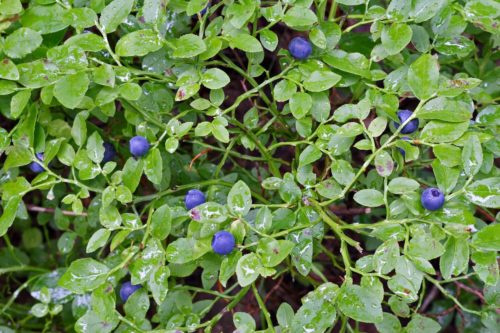
Blueberry. I have come across a preconceived opinion that blueberries are not suitable for tea! Like, blueberry tea is nonsense! Actually this is not true! The taste and aroma of tea made from blueberry leaves resembles the taste of the berries themselves, but lacks sourness and is not so pronounced. Both the leaves and stems and the berries themselves are used to make tea. To achieve a rich taste, aroma and color, you need to infuse blueberry leaves for quite a long time, more than 15 minutes! Also, blueberry leaves and berries go well with the leaves of other plants suitable for making tea.
Blueberry tea is good for preventing scurvy, rich in vitamins B1, C, PP. Contains such useful substances as calcium, phosphorus, iron, manganese, organic acids, tannins and pectin substances, essential oil, carotene. Blueberry tea is also used to treat diabetes; it can lower blood sugar levels. Tea also has diuretic and anti-inflammatory properties. It is also used for diarrhea and in the treatment of colds; whatever one may say, both can happen on a hike, as well as in survival conditions.
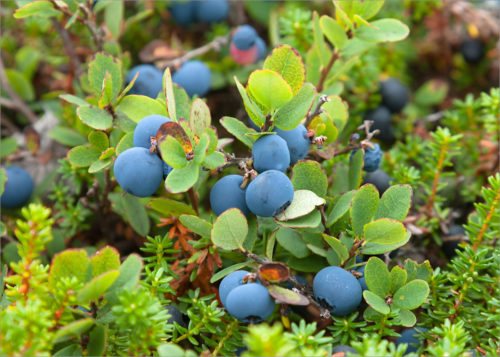
Blueberry. Quite a controversial plant for tea. In appearance, it is very similar to blueberries (it differs in its large size, the taste of the berries is sickly sweet, blueberries have a sour taste. The flesh of the berries is greenish with clear juice), however, in the territory of central Russia, blueberries are much less common. Unlike blueberries, not everything is so simple with this berry!
In some sources it is even called a poisonous berry!!! It says that if you eat a lot of blueberries you may experience: headache, nausea and vomiting. Meanwhile, research was carried out and no toxic substances were found in the berry. There is an opinion that blueberries can acquire toxic properties as a result of wild rosemary, which often grows next to it, the essential oils of which fall on the hands of the person picking the berries, and from them onto the blueberries and then the berries into the body.
So in any case you should be careful, it is also better to decide in advance for yourself whether it is worth the risk? Even a seemingly insignificant risk in extreme conditions can cost you your life.
Personal experience: I ate blueberries, not much, but I ate them. Seems OK! Unfortunately, I didn’t drink tea, so I won’t give any special advice, but the very possibility of toxicity is annoying and I’m writing about blueberries more for the sake of completeness. And yet, as people write, in terms of its medical properties, blueberry tea is similar to the medicinal properties of blueberries and lingonberries, and it is not deprived of any benefits. By the way, blueberry leaves are harvested at the time of flowering of the plant, from May to June.

Strawberries. Excellent raw materials for tea, healthy and very popular! And for good reason! Strawberry leaves contain ascorbic acid (goodbye scurvy). Strawberry flowers are also useful to add to tea; they contain substances that help strengthen capillaries! And in general, strawberries have always been considered by the Russian people almost a panacea for all diseases! Strawberry tea is good for colds, vitamin deficiency, gout, and kidney and liver diseases. Strengthens the cardiovascular system, is recommended for all kinds of ailments with blood circulation, normalizes the functioning of the gastrointestinal tract.
When to pick strawberries for tea? If we talk about beneficial properties, strawberry leaves are most valuable in the fall, which is when picking is recommended. In hiking conditions, I think this is not so important.
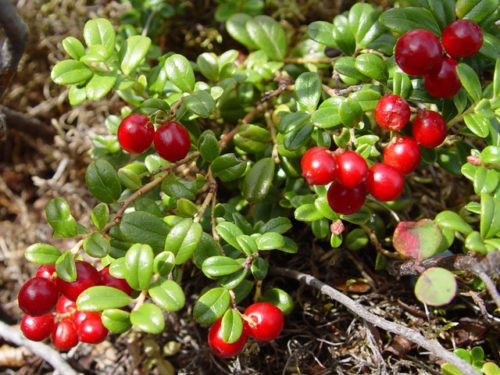
Cowberry. Not only does it have an excellent, pronounced taste, but also a very powerful healing effect (in some cases comparable to pharmaceutical drugs). It is impossible not to list at least some diseases that are treated with lingonberry infusion: headache, lung disease, hypertension, cystitis, cholelithiasis and urolithiasis, pyelonephritis and others. Thanks to the benzoic acid contained in the plant (an excellent natural preservative), lingonberries have an anti-inflammatory and antibacterial effect. The plant is rich in vitamins, strengthens the immune system well and is certainly useful as a preventive measure.
Since the therapeutic effect is quite strong, it is not recommended to drink this tea for a long time, especially for people with kidney failure (it is better to consult a doctor on this issue), with low blood pressure and a tendency to it, with high stomach acidity and children under 12 years old. Pregnancy is not a contraindication, however, it can cause uterine tone, so if this has already happened, it is better not to drink this tea.
I would like to add that I really love lingonberry tea, however, the Bryansk region suffered quite significantly from the accident at the Chernobyl nuclear power plant, and therefore the issue of radioactive contamination of the area is relevant, and unfortunately, lingonberry leaf in this regard accumulates radiation quite strongly (more about accumulation radiation mushrooms, berries and herbs in this article ). On the other hand, I took measurements of the lingonberry leaves I collected for contamination using a dosimeter, and it didn’t record anything terrible! So I drink!
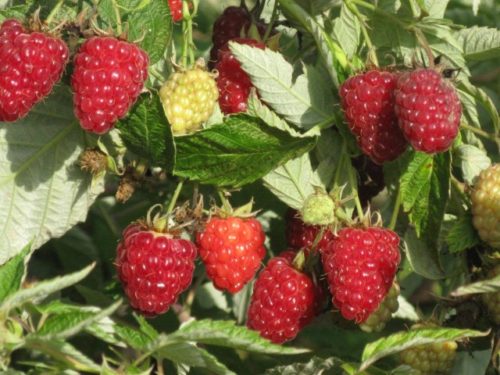
Raspberries. A very healthy tea with valuable medical properties about which you can write a lot. The taste of the tea is tart and pleasant. But raspberry tea also has contraindications: chronic constipation, pregnancy up to 32 weeks, individual intolerance to the body, gout, nephritis.
Raspberry leaves contain malic, tartaric, and citric acid, which not only stimulates the digestion process and appetite, but also prevents the development of all kinds of intestinal infections, adversely affecting the development of fungi, viruses and harmful microorganisms.
Tea made from the leaves is rich in vitamins E, K, C, which increase immunity, and a decoction of raspberry leaves has hemostatic, diaphoretic, expectorant, antipyretic properties, and relieves stress. It is used as a remedy for viral diseases (colds, flu, bronchitis), as a lotion for symptoms of hemorrhoids, diarrhea and other diseases of the gastrointestinal tract, to accelerate wound healing, gynecological ailments and in many other cases.
According to the rules, raspberry leaves are harvested in August from the 1st to the 10th, and this tea is drunk from November to March. The leaves are not cut off just any way, but only from the top of the shoot. Prepare tea by boiling a handful of dry leaves for 10-15 minutes, then let it brew.
Naturally, it is not possible to follow all the procedures for proper collection on a hike, and sometimes you don’t have the energy or time to chase the maximum benefit from a plant (this can be said about any tea prepared on the go from what can be found). There are, of course, exquisite gourmets, such, for example, they even carry porcelain mugs with them, which I do not blame... You can also carry pre-prepared tea from raspberry leaves (according to all the rules) with you, but with us we are talking primarily about survival and simply about satisfying the need for a hot drink, therefore the benefits will be obtained even without exact instructions for collection.
Tea made from raspberry twigs. Raspberry stems are also used for tea, and in this case, it is freshly cut stems (one-year-olds) that bring the greatest benefit, but dry ones will also work, especially if you are in a winter forest! In winter, it’s easy to find raspberry stems, which means you won’t be left without tea. Tea made from raspberry stems is good for colds, bronchitis, coughs, flu, inflammation of the respiratory tract, hemorrhoids, stomach bleeding, abdominal pain, heartburn, skin diseases, to improve blood clotting, as a prevention of atherosclerosis, and also as a means of strengthening the immune system. Tea made from raspberry twigs helps with neurasthenia and a tendency to depression.
However, for all its usefulness, a drink made from raspberry stems not only has a fairly strong medical effect, but also has a number of contraindications. The drink can be harmful to health if a person suffers from gout, as well as urolithiasis.
But the most mysterious side effect is the poorly studied effect of this drink on a person’s hormonal state. The fact is that raspberry twigs contain substances that have hormonal effects, which are poorly studied. From observations it was noted that in some situations when this drink was used, it had a negative effect on the thyroid gland and pituitary gland. Which suggests the conclusion that you need to know when to stop, and really use it for its intended purpose for ailments. And in general, be careful if you still use it as tea.
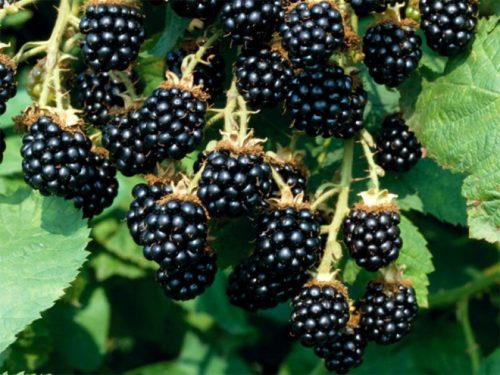
Blackberry. Blackberry tea is not inferior to raspberry tea in its beneficial properties, and even surpasses it in its vitamin composition (B vitamins are present)! The decoction will help with sleep disorders, dysentery (brew stronger), severe menstrual pain, increased excitability, improve intestinal function, help with gastric and pulmonary bleeding, etc. You can also treat wounds with blackberry decoction, as it has an antiseptic effect. It can cause harm if you are allergic to this berry, and there may also be discomfort in patients with ulcers.
It is recommended to collect blackberry leaves in the spring, during the period of active growth, before flowering.
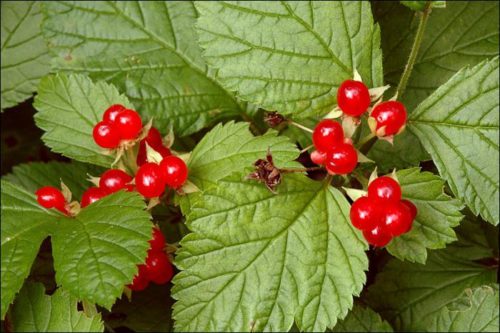
Stone berry. This relative of raspberries and blackberries is much less common here than many other berries. For example, I tried it only last year (we are talking about the berries themselves, I haven’t drunk the tea yet). The berry is really healthy and tasty (it tastes sour and feels like a cross between a cherry and a pomegranate.). Nevertheless, knowledgeable people write that tea made from stone fruit leaves is very useful, tasty and helps with various ailments of the gastrointestinal tract, suffocation, hemorrhoids and other diseases.

Cranberry. Cranberry tea also has powerful medicinal benefits! This drink is traditionally consumed after a bath. It is believed that it helps remove harmful salts from the body and helps with rheumatism, especially if it is steamed well. They also drink it for heartburn, headaches, shortness of breath, etc. There are also contraindications, namely: increased stomach acidity, acute diseases of the gastrointestinal tract, stomach and duodenal ulcers, liver disease.
To briefly summarize the first part, I would like to say that, of course, not all the berries that can be found in the forest were included here; I also did not describe the berries growing in gardens. I would like to once again draw your attention to the fact that some side effects or, on the contrary, beneficial properties of tea may not be described here, so if you have any health problems, it is best to check this information from other sources!
Also, this material should not be regarded as instructions for self-medication, although certainly some of the described properties can be useful in the absence of other medical means during a hike and survival in extreme situations.
Article Rating
Post Views: 4,070
Related posts:
pluvo27 05/30/2016 Questions of food: tea on a hike, wild berry tea, berry leaf tea 1 comment
Classic breakfast, lunch and dinner on a hike
The classic writing technique is quite modest and looks something like this for a large group.
- Breakfast. Porridge from cereals or flakes with raisins, biscuits with cheese or sausage, tea/coffee/cocoa.
- Lunch-snack. Biscuits with cheese or sausage, dried fruits and nuts, energy bars.
- Lunch at the camp. Soup + biscuits with something, tea.
- Dinner. Cereal porridge with stew, biscuits with cheese or sausage, tea.
Of course, for a small group the menu can be varied. For a large one for 15-20 people, it’s quite complicated. In a small group, to quickly prepare breakfast and dinner, it is convenient to use packaged cereals (such as Uvelka), which just need to be poured with boiling water.
A simple recipe for delicious camp soup over a campfire.
What's best for a midday snack?
For a one-day hike, creating a “delicious” snack menu is not difficult. For a multi-day hike, it is quite monotonous and differs only in chocolate bars.
- biscuits with hard cheese or raw smoked sausage;
- dried fruits and nuts;
- candied fruit;
- energy bars (Mars, Snickers, Bounty, Twix, etc.).

Layout example
Approximate weight of products for laying out.
After the daily menu has already been compiled, multiply the weight of food for each meal by the number of hikers.
Porridge is the most important food on a hike.
| Products | Weight in grams (per adult tourist, per meal) |
| Cereals | 80-100 |
| Hercules and other cereals | 60-80 |
| Mashed potatoes | 60-80 |
| Hard cheese | 30-40 |
| Salo/basturma | 20-40 |
| Smoked sausage | 30-40 |
| Stew | 50-60 |
| Dried meat | 20-25 |
| Powdered milk | 20-30 |
| Candied fruit | 20-30 |
| Nuts | 15-30 |
| Dried fruits | 40-50 |
| Chocolate bars | 50-60 |
| Biscuits/crackers | 40-50 |
| Pasta | 90-110 |
| Semolina | 50-60 |
| Garlic | 5-10 |
| Lemon | 5 |
| Products | Weight in grams (per tourist per day) |
| Salt | 5-7 |
| Sugar | 20-30 |
| Tea | 8-10 |
| Spices | 5-10 |
When drawing up the layout, take into account the possible allergic intolerance of some products by the participants of the hike and the presence of vegetarians.
Product packaging.
The prevailing theory at the moment advises packing everything that can be put into plastic bottles. This allows you to save space in a hermetic bag, and cases of a plastic bottle losing its seal are considered folklore.
The disadvantages of this method include the need to prepare bottles in advance (after washing, they take 1–3 days to dry). You also need to remember that many products are easy to put into a bottle, but not easy to take out. To varying degrees, this applies to rolled oats, pasta, ghee, and sweets.
A few small tips:
To pour cereal into a bottle, it is convenient to use not an ordinary funnel, but a wide-necked funnel made from another bottle. You can also use two caps and electrical tape to make a threaded adapter and free up your other hand.
If you have a choice, it is better to use bottles other than Pepsi and Coca-Cola products. The latter are 30–40% heavier and, due to their more elaborate shape, occupy more volume.
A historical alternative for bulk products is the combination of a plastic bag inside and a cloth bag outside. If you are confident in the strength of the herm, you can leave only the cloth bag. Advantages of this method:
- saves backpack volume;
- suitable for almost any product;
- allows you to pre-arrange food into meals without increasing the volume by 20–30%;
- the packaging weighs 2–3% of the contents, and not 5–10, as in the case of plastic bottles.
A more modern version of the same thing is to put the product in a plastic bag, suck out the air and wrap it with wide tape in 1-2 layers. If everything is done carefully, the resulting bags can be transported without a seal (although it is still better not to do this).
General Tips
Before long hikes, it is convenient to mix the porridge ingredients in advance and distribute them among the meals, which allows you not to think about anything during the hike, but simply pour the bag into the pot. In addition, the milk powder is automatically stirred and the semolina does not clump.
Even good packaging does not always protect products from being stained with gasoline or glue. Therefore, keep food away from the repair kit.
In many cases, the factory packaging is not suitable for camping. Think about what you can replace it with.
Factory packaging has proven itself well in the following cases:
- tin cans;
- vacuum packaging made of polyethylene with foil (sliced sausages, mashed potatoes, soups).
Try to leave all the paper in Moscow - labels, boxes,... You will not get any pleasure from the wet mess at the bottom of your backpack or jacket. I'm not even talking about weight.
Rigid packaging (tin cans and, to a lesser extent, plastic bottles) should not touch the backpack or the bottom of the kayak, otherwise hitting rocks can damage both the food and the backpack/boat. The most egregious example is a can of stewed meat in the bottom pocket of a backpack, or it’s edge-on, for added effect, on top of a backpack tied to a cat. With a keel, the chances of sinking the jar and soaking all your clothes become comparable to 1/2.
Tips for Packaging Difficult Products
With sufficient care, ghee can also be stored in its original boxes. But it’s better to put it in jars with a screw cap into which a spoon fits, for example from mayonnaise or Danone kefir.
It is better not to keep oil in plastic bottles - it is very difficult to squeeze out without preheating.
Crackers and biscuits. I know 3 ways:
- wrap a daily or one-time portion in a newspaper to prevent it from getting damp, then in an old stocking, pulling it tight so that the pack keeps its shape, and finally in a plastic bag so that it does not get wet;
- the same thing, but without the stocking, and wrap the bag tightly with tape, so that you get a rigid package;
- carefully place it in a juice bag and seal it tightly with tape.
In the latter case, the weight of the package is significantly greater, but the safety of the product in case of careless handling is also higher.
Pasta and other large and spicy bulk products: if you take a lot, you can put it in 5-liter water bottles. Another option is bag + plastic bag + bag. Or just in a bag, if you are confident in your herm.
Rafinated sugar. Seal the box with tape. Remember that sugar can absorb an amount of water comparable to its weight simply from the air.
Freeze-dried products
More than a dozen companies produce freeze-dried products in Russia.
During sublimation, most of the moisture is removed by vacuum, but all taste, color, minerals and trace elements are preserved. The weight of the products is reduced by 5-10 times. Next, everything is packaged in vacuum bags.
The range of products and ready-made dishes is quite wide, including freeze-dried pickles, sour cream, shrimp and omelettes.
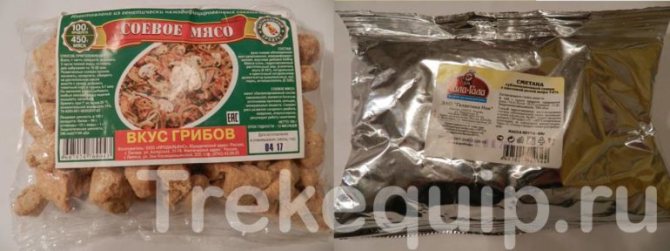
“Proper” food on the track. What is “fast” and “slow sugar”
While hiking, our body needs quite a lot of energy. The main help here is provided by carbohydrates, which are contained in all foods, but play different roles. As soon as we eat something, “fast” or “slow” sugar immediately begins to enter the blood. “Fast sugar” gives an immediate burst of energy, while “slow” sugar comes gradually, over several hours, and steadily maintains our energy level.
- “Fast sugars” include many sweets, foods high in starch, cookies, and sweet fruits.
- “Slow sugars” include many cereals and cereals, pasta, non-starchy vegetables, mushrooms, and unsweetened fruits.
Boiled or baked vegetables have a higher glycemic index, meaning they contain more sugar than fresh ones.
When choosing food for your hike, focus on cereals, in particular buckwheat - this is an ideal source of energy and microelements. And the monotony of porridges is perfectly brightened up by spices and fire smoke.
Purchase of products and their replenishment
This point of preparation for the trip is handled by the supply manager - a selected person who draws up the layout, controls food supplies, and distributes dry rations. He also manages the purchase of products.
It is best to purchase products at the market. You will need a lot of them, and the trip is a very expensive undertaking. In addition, an undeniable advantage of the market is the opportunity to try, inspect, and touch the product being purchased.
Sublimated products can be ordered through the online store. It's both cheaper and more convenient. Moreover, in the modern world, you can read reviews about almost everything and find a manufacturer that others have tried.
If the route passes through populated areas, provision can be made for replenishing supplies there. It is better not to use the services of impromptu markets ; the quality of the products cannot be checked, and the consequences can be disastrous and delay the entire expedition.
Also, products can be replenished using natural resources. We are talking about mushrooms, berries and living creatures. It’s great if you’re parking near a pond—you can fry some fish or cook some amazing fish soup. In addition, you can bake acorns and corn in coals. Or fry freshly picked mushrooms.
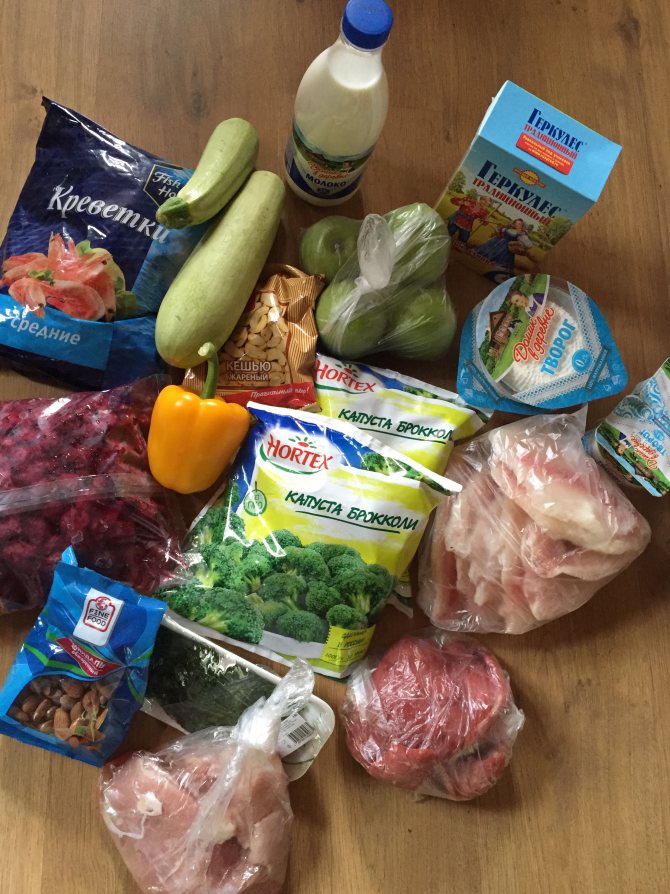
In addition, you can stock up while on a hike. For example, you can dry mushrooms over a fire. This will require luck, because without it it is difficult to find a mushroom clearing in an unfamiliar area, a rich harvest, a knife and sticks. The rafts, cleared of dirt, are strung on sticks and stuck around the fire. A few hours and the supplies are ready.
The next day you can cook a delicious mushroom soup.
Author of the publication
offline 2 years
Nika
7
I am interested in hiking and traveling, photography and videography. I have been going hiking since childhood. The whole family went and went - sometimes to the sea, then to the river, to the lake, to the forest. There was a time when we spent a whole month in the forest. We lived in tents and cooked over fires. This is probably why I am still drawn to the forest and, in general, to nature. I travel regularly. About three trips a year for 10-15 days and many 2 and 3 day hikes.
Comments: 0Publications: 668Registration: 10/23/2018
Nika Survival in the wild, Nutrition in the wild, Articles






